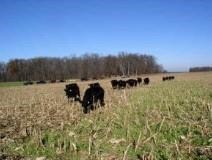By Jason Hartschuh
Utilizing corn fodder residue for livestock to graze to meet their nutritional needs is a less expensive option than buying or utilizing your own stored forages. Crop residue can provide an inexpensive feed source for 65-111 days into the winter. Beef cattle can successfully graze corn residue through 4 to 6 inches of snow cover. The cows will not be able to graze stalk field that get covered in ice.

Properly managed, crop residue can provide an inexpensive feed source for 60+ days.
When grazing residue, the livestock will be selective grazers, first eating the grain they can find followed by husks and leaves, leaving the cobs and stalks for last. Under normal conditions there is about 1 bushel of grain per acre in the field. Increased grain can be present when there is excessive header losses or the crop goes down due to weather conditions. Excessive amounts of grain present or piles do to an equipment break down can cause grain overload that could result in bloat or death in livestock. Typically, this is not a problem unless there is more than 8-10 bushels per acre of corn on the ground. When the cows are able to graze husks, leaves, and a very small amount of grain they are able to consume a diet consisting of 52 to 55 percent total digestible nutrients (TDN) and a 5-5.5 percent crude protein diet.
Stocking density and grazing method greatly effects the diet of grain, husks, and leaves available for each animal to eat since they have the highest nutrient density. Livestock should not be forced to eat stalks or cobs as they are low in nutrition and leaving these in the field protects the soil from erosion. On average there is 16 pounds of leaves and husks per bushel of corn harvested. We recommend that only 30-50 percent of this residue is grazed. Meaning about 864-1,440 pounds of fodder is available per acre with a 180-bushel yield. Another way to look at this is the bushels of grain yield per acre divided by 3.5 equals the number of grazing days per acre available. (180 bushel yield/3.5=51 grazing days per acre for one animal or 51 head per acre per day.
Under whole field grazing the nutritional quality begins at approximately 70% TDN and decrease to around 45% TDN as the livestock select the high equality fodder to graze first along with some environmental decomposition of the fodder. While whole field grazing is the simplest option, strip grazing improves diet quality. Strip grazing is highly recommended if you have high grain losses in the field. Strip grazing also decreases the need for later season supplementation.
One very important part of grazing cows on cow fodder is to body condition score them before turning on pasture to determine possible supplementation needs. Mature non-lactating cows that will calve in the spring will not need protein supplementation as long as their body condition score is 5 or higher. First calf heifers who have not reached their mature body weight though will need protein and energy supplementation during the last 90 days prior to calving to meet their nutritional needs. Feeding 3.5 lbs per head per day of dried distillers’ grains or equivalent would meet these needs.
Fall calving cows can also be grazed on corn fodder but will need additional protein and energy to meet their maintenance and lactation needs. This supplementation is about 3.5 lbs. of a diet that is at least 30% protein and 90% TDN. This can be reached in many ways including 5 lbs. of dried distillers grains.
If you need to background calves, corn stalk grazing can be used for this also. The target gain for background calves is to gain 1 pound per day. In order to meet these needs, you will need to provide an additional supplementation of protein and energy. Research from the University of Nebraska shows this can be done with a supplementation of 2 pounds of dried distillers grain per day or equivalent.
Besides a portable watering system compaction during grazing is the greatest concern with when grazing corn fodder. When stocking rate were optimized for animal performance research has shown that there is not a decrease in the following no-till soybean crop yield between ungrazed and grazed areas of the field. The corn crop 2 years after grazing also didn’t show and yield decline from grazing corn fodder. When leaving cattle on the fields into March and April through care must be taken not to compact soils. Grazing corn stalks can be an excellent economic decision to allow you to feed your cows for the winter or even sell stored forage.
Source : osu.edu